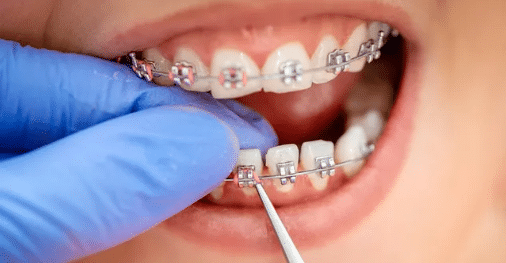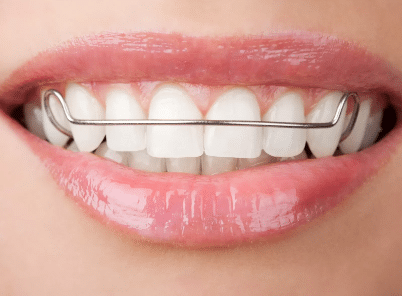Sudden gap between teeth? Have you noticed a sudden gap between your teeth that wasn’t there before? If you feel like the gap between your teeth is increasing with age, here’s why it’s happening and how you can prevent it.
Sudden Gap Between Teeth – Diastema

Sudden gap between teeth also known as diastema refers to a gap between your teeth. Gaps can occur anywhere in your mouth, but they’re most common between your two front teeth.[mfn]https://www.medicalnewstoday.com/articles/diastema[/mfn]
This condition is usually a cosmetic concern, but sometimes, it’s related to gum disease. Diastema treatments include dental bonding, porcelain veneers, and braces.
Gaps between your teeth may be small or large. Diastema usually doesn’t have a negative impact on your oral health. However, in some cases, it could be a symptom of gum disease.
Who Does Sudden Gap Between Teeth (Diastema) Affect?
Diastema affects both children and adults. The condition is more common in children, and gaps between their teeth may close once their permanent (adult) teeth come in.
Midline diastema (when there’s a gap between the two upper front teeth) is more common among certain populations. For example, people who are Black are more likely to have diastema compared to people who are white people or of Asian descent.
Is Sudden Gap Between Teeth (Diastema) Normal?
Yes. Diastema is a common occurrence, and most healthcare providers view it as a variation of normal dental development.
How Does Sudden Gap Between Teeth (Diastema) Affect Your Oral Health?
Most of the time, diastema shouldn’t cause any oral health concerns. However, if the gap between your teeth is due to periodontitis, you may need gum disease treatment.
Symptoms and Causes of Sudden Gap Between Teeth (Diastema)
There’s only one sign of a sudden gap between teeth (diastema), and that sign is simply as it is; a gap between teeth. If your teeth and gums are healthy, there usually aren’t any other symptoms.
If gum disease causes a gap between the teeth, you may notice pain, redness, swelling, or other gum disease symptoms.
What Causes a Sudden Gap Between Teeth (Diastema)?
1. Natural aging process
As we grow older, our bodies undergo various transformations, and our oral health is no exception. “With age, the elasticity of the gum tissues and ligaments supporting the teeth tends to decrease.
This can lead to a shift in the position of teeth, causing gaps to form,” says Dr Vipin Dehane, HOD-Dentistry, and Maxillofacial Surgery, Fortis Hospital, Mulund, Mumbai. While this natural aging process affects everyone differently, it’s not uncommon to observe a gradual increase in the spaces between teeth over
2. Periodontal disease
Gum diseases such as periodontitis can significantly impact oral health, particularly as we age. Dr Dehane explains that these conditions can damage the supporting structures of the teeth, including the gums and underlying bone, leading to tooth loss.
When teeth are lost, the remaining teeth may shift, creating spaces between them. The tendency to develop gum diseases increases with age, making the occurrence of diastema more noticeable as we grow older.
3. Teeth Grinding (Bruxism)
Dr. Dehane believes persistent teeth grinding, known as bruxism, can also be a reason for sudden gaps between teeth. As it can exert excessive pressure on the teeth. Over time, this can cause enamel erosion and compromise the stability of teeth.
As a result, the teeth may gradually shift, creating gaps between them. The changes caused by bruxism happen gradually over a long period, often becoming more pronounced with age.
Many people are genetically prone to diastema. That’s why the condition sometimes runs in families. This may be caused by:
- Missing teeth.
- Teeth that are too small.
- An oversized frenum (the band of connective tissue that connects your lip to your gums).
In some cases, diastema may develop because of an abnormal swallowing reflex. For example, your tongue should press against the roof of your mouth when you swallow. However, if you press your tongue against your front teeth instead, the repetitive pressure can cause a gap to form over time.
For some people, gaps between their teeth form as a result of advanced gum disease. With this condition, infection erodes your jawbone, causing gaps and loose teeth.
Diagnosis and Tests
Your dentist can diagnose diastema during a routine dental exam. No further testing is required.
Management and Treatment
There are several ways to fix diastema. Treatment depends on whether the condition is due to gum disease or if it’s only a cosmetic issue.
Cosmetic treatments for diastema
If your teeth are healthy and you simply wish to close the gap between your teeth, there are several cosmetic dental treatments available, including:
- Dental bonding: Your dentist applies a tooth-colored composite resin material to conceal the gap. Then, your teeth are shaped and polished for a natural appearance.
- Porcelain veneers: These are custom-made ceramic shells that permanently adhere to your front tooth surfaces. They can close down a gap between the teeth for a more uniform look.
- Braces: If the gap is large, you may need braces or clear orthodontic aligners to physically move your teeth closer together. (In mild cases, your dentist can usually fix diastema without braces.)
- Frenectomy: An oral frenum is a band of tissue that connects your lip to your gums. If this piece of tissue is too thick, it can push your teeth apart, creating a gap. A frenectomy releases this band of tissue. In many cases, frenectomy is performed in combination with another cosmetic procedure, such as dental bonding or veneers.
- Dental bridge: If the gap between your teeth is due to a missing tooth, your dentist may recommend a bridge to replace it. To place a bridge, you must have two healthy teeth on either side of the gap. These teeth will be altered to serve as anchors for your new restoration.
- Dental implant: Like a dental bridge, an implant replaces a missing tooth. But with a dental implant, there’s no need to alter the neighboring teeth. An implant is a threaded titanium post that replaces a missing tooth root. Once it’s healed, a dental crown is used to restore it and close the gap between your teeth.
Gum disease treatments for diastema
If diastema is the result of gum disease, then you’ll need periodontal treatment first to get rid of harmful bacteria. Once the infection is under control, you can choose to address the gap between your teeth with one of the cosmetic treatments listed above.
Common gum treatments include:
- Scaling and root planing: If you have mild gum disease, your dentist may recommend scaling and root planing — a deep dental cleaning. It’s similar to a regular cleaning, but you’ll be numb so your provider can reach bacteria that are hiding deep under your gums.
- Gingival flap surgery: If you have moderate to advanced gum disease, you may need gum surgery. During this procedure, your periodontist creates an incision along your gum line, then temporarily moves your gums back so they can see your teeth roots. After thoroughly cleaning your teeth roots, your gums are repositioned and sutured (stitched) back into place. If you have bone loss around a tooth, your surgeon may also place a dental bone graft to help regenerate bone tissue in that area.
Prevention – Can You Prevent Sudden Gap Between Teeth (Diastema)?
1. Good oral hygiene:

Maintaining proper oral hygiene practices is crucial for overall oral health. Dr Dehane advises that brushing your teeth twice a day, flossing regularly, and visiting your dentist for routine check-ups and cleanings can help prevent gum diseases and tooth decay.[mfn]https://www.healthshots.com/preventive-care/self-care/sudden-gap-between-teeth-why-it-happens-and-how-to-prevent-it/[/mfn]
By addressing these underlying oral health issues, you can reduce the risk of tooth movement and the development of diastema.
2. Wear a mouthguard:

If you have a habit of grinding your teeth, known as bruxism, wearing a customized mouthguard while sleeping can provide protection and help minimize the risk of tooth wear and movement.
A mouthguard acts as a cushion, reducing the pressure on your teeth and preventing the widening of gaps.
3. Seek orthodontic treatment

If you’re concerned about the gap between your teeth, consulting an orthodontist can provide valuable insights and treatment options. Braces or aligners can be used to gradually bring the teeth back into proper alignment, reducing the gap, and enhancing your smile.[mfn]https://my.clevelandclinic.org/health/diseases/23477-diastema[/mfn]
Orthodontic treatment may involve realigning specific teeth or addressing overall dental arch discrepancies, depending on your unique needs.
4. Consider dental implants or bridges

In cases where tooth loss has occurred, dental implants or bridges can be considered to fill the gaps and prevent the remaining teeth from shifting. These restorative options not only improve the aesthetics of your smile but also help maintain the integrity and alignment of neighboring teeth.
5. Use retainers

After completing orthodontic treatment, wearing retainers as prescribed by your orthodontist is essential. “Retainers help maintain the alignment achieved through orthodontic intervention and prevent the gap from reappearing,” says Dr Dehane.
Consistency in retainer use is crucial to ensure long-term success in preserving the desired tooth alignment.
But in truth, there’s no way to prevent diastema when it’s caused by genetics. It’s simply a characteristic that your parents or grandparents passed down to you.
However, you can reduce your risk of infection-related diastema by practicing good oral hygiene and visiting your dentist for regular cleanings and exams. If you notice redness, swelling, bleeding, or other signs of gum disease, schedule a visit with your dentist right away.
You can watch the video below to know more fixes for sudden gap in teeth:
Outlook/Prognosis – What Can You Expect If You Have Diastema?
Unless diastema is caused by infection, it’s nothing to worry about. It doesn’t have a negative impact on your oral health. In fact, many people embraced the gap between their teeth as a unique characteristic of beauty.
If you prefer to close the gap between your teeth, there are plenty of treatment options available to help you reach your cosmetic goals.
Does Sudden Gap Between Teeth (Diastema) Increase With Age?
In a healthy mouth, diastema shouldn’t increase with age. If you notice the gap between your teeth is getting wider, call your dentist, as it could be due to gum disease.
Living With Sudden Gap Between Teeth (Diastema)
When should you see a dentist? If you’re bothered by the gap between your teeth, schedule a consultation with your dentist. They can discuss your treatment options with you in detail.
In general, be sure to see your dentist at least every six months for regular dental exams and cleanings.
A Final Note from Bornfertilelady
In most cases, a sudden gap between teeth (diastema) is nothing to worry about. It doesn’t affect your oral health or function. In fact, a gap between your teeth is considered a mark of beauty by many cultures around the world.
But if you decide you’d rather close the gap, cosmetic dental treatments can help you achieve the healthy, gorgeous, and long-lasting smile you desire.

